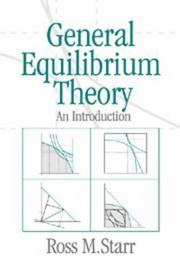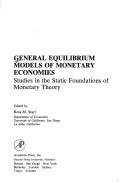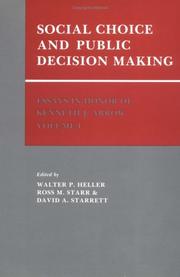| Listing 1 - 10 of 10 |
Sort by
|

ISBN: 0521564735 052156414X 1139174746 9780521564144 9780521564731 9781139174749 Year: 1997 Publisher: Cambridge Cambridge University Press
Abstract | Keywords | Export | Availability | Bookmark
 Loading...
Loading...Choose an application
- Reference Manager
- EndNote
- RefWorks (Direct export to RefWorks)
General Equilibrium Theory: An Introduction treats the classic Arrow-Debreu general equilibrium model in a form accessible to graduate students and advanced undergraduates in economics and mathematics. Topics covered include mathematical preliminaries, households and firms, existence of general equilibrium, Pareto efficiency of general equilibrium, the First and Second Fundamental Theorems of Welfare Economics, the core and core convergences, future markets over time and contingent commodity markets under uncertainty. Demand, supply, and excess demand appear first as (point-valued) functions, then optionally as (set-valued) correspondences. The mathematics presented (with elementary proofs of the theorems) includes a real analysis, the Brouwer fixed point theorem, and separating and supporting hyperplane theorems. Optional chapters introduce the existence of equilibrium with set-valued supply and demand, the mathematics of upper and lower hemicontinuous correspondences, and the Kakutani fixed point theorem. The treatment emphasizes clarity and accessibility to the student through use of examples and intuition.
Microeconomics --- Quantitative methods (economics) --- Equilibrium (Economics) --- Economics, Mathematical --- Equilibre (Economie politique) --- Mathématiques économiques --- 330.1 --- Disequilibrium (Economics) --- Economic equilibrium --- General equilibrium (Economics) --- Partial equilibrium (Economics) --- Economics --- Stagnation (Economics) --- Statics and dynamics (Social sciences) --- Mathematical economics --- Econometrics --- Mathematics --- Economische grondbegrippen. Algemene begrippen in de economie --- Methodology --- Economics, Mathematical. --- 330.1 Economische grondbegrippen. Algemene begrippen in de economie --- Mathématiques économiques --- DGE (Economics) --- DSGE (Economics) --- Dynamic stochastic general equilibrium (Economics) --- SDGE (Economic theory) --- Business, Economy and Management
Book
ISBN: 9780521826457 9780521533867 9780511975356 Year: 2011 Publisher: Cambridge Cambridge University
Abstract | Keywords | Export | Availability | Bookmark
 Loading...
Loading...Choose an application
- Reference Manager
- EndNote
- RefWorks (Direct export to RefWorks)
"General Equilibrium Theory: An Introduction presents the mathematical economic theory of price determination and resource allocation from elementary to advanced levels, suitable for advanced undergraduates and graduate students of economics. This Arrow-Debreu model (known for two of its most prominent founders, both Nobel Laureates) is the basis of modern price theory and of a wide range of applications. The text starts with elementary models: Robinson Crusoe, the Edgeworth Box, and a 2-commodity 2-household 2-firm model. It gives a brief introduction to the mathematics used in the field (continuity, convexity, separation theorems, Brouwer fixed-point theorem, point-to-set mappings, and Shapley-Folkman theorem). It then presents the mathematical general equilibrium model in progressively more general settings, including point-valued, set-valued, and non-convex set-valued demand and supply. Existence of general equilibrium, fundamental theorems of welfare economics, core convergence, and futures markets with time and uncertainty are treated fully. The new edition updates discussion throughout and expands the number and variety of exercises. It offers a revised and extended treatment of core convergence, including the case of non-convex preferences, and introduces the investigation of approximate equilibrium with U-shaped curves and non-convex preferences"--
Microeconomics --- Quantitative methods (economics) --- Equilibrium (Economics) --- Economics, Mathematical --- AA / International- internationaal --- 331.01 --- Evolutie van de economische cycli. --- DGE (Economics) --- Disequilibrium (Economics) --- DSGE (Economics) --- Dynamic stochastic general equilibrium (Economics) --- Economic equilibrium --- General equilibrium (Economics) --- Partial equilibrium (Economics) --- SDGE (Economic theory) --- Economics --- Statics and dynamics (Social sciences) --- Mathematical economics --- Econometrics --- Mathematics --- Evolutie van de economische cycli --- Methodology

ISBN: 0126639701 1322470855 1483273512 9780126639704 Year: 1989 Publisher: Boston San Diego New York : Academic Press,
Abstract | Keywords | Export | Availability | Bookmark
 Loading...
Loading...Choose an application
- Reference Manager
- EndNote
- RefWorks (Direct export to RefWorks)
Equilibrium (Economics) --- Money. --- Value. --- 330.1 --- 336.74 --- 330.115 --- Money --- Value --- AA / International- internationaal --- CG / Congo --- 333.401 --- 333.402 --- 333.400 --- 382.20 --- 333.403 --- 382.11 --- 380.1 --- Standard of value --- Cost --- Economics --- Exchange --- Wealth --- Prices --- Supply and demand --- Currency --- Monetary question --- Money, Primitive --- Specie --- Finance --- Banks and banking --- Coinage --- Currency question --- Gold --- Silver --- Silver question --- Disequilibrium (Economics) --- Economic equilibrium --- General equilibrium (Economics) --- Partial equilibrium (Economics) --- Stagnation (Economics) --- Statics and dynamics (Social sciences) --- Economische grondbegrippen. Algemene begrippen in de economie --- Geld. Geldwezen. Monetaire sector. --- Econometrie --- Begrip en functies van het geld. --- Geldschepping en geldvernietiging. Multiplicator van het krediet. --- Geldwezen: algemeenheden. --- Internationale betalingen en betalingsbalans: algemeenheden. --- Monetaire theorieën. Kwantitatieve theorie. Theorie van de incasso's. Optiek van de uitgaven en inkomens. --- Theorie van het internationale evenwicht. Economische onafhankelijkheid van een natie. Globalisering. Mondialisering. --- Waardeleer. --- Equilibrium (Economics). --- 330.115 Econometrie --- 336.74 Geld. Geldwezen. Monetaire sector. --- 330.1 Economische grondbegrippen. Algemene begrippen in de economie --- DGE (Economics) --- DSGE (Economics) --- Dynamic stochastic general equilibrium (Economics) --- SDGE (Economic theory) --- Geldwezen: algemeenheden --- Begrip en functies van het geld --- Geldschepping en geldvernietiging. Multiplicator van het krediet --- Monetaire theorieën. Kwantitatieve theorie. Theorie van de incasso's. Optiek van de uitgaven en inkomens --- Waardeleer --- Theorie van het internationale evenwicht. Economische onafhankelijkheid van een natie. Globalisering. Mondialisering --- Internationale betalingen en betalingsbalans: algemeenheden --- Geld. Geldwezen. Monetaire sector --- Équilibre (économie politique) --- Monnaie --- Equilibrium (economics) --- Valeur
Book
ISBN: 9781848448568 1848448562 Year: 2012 Publisher: Cheltenham Edward Elgar
Abstract | Keywords | Export | Availability | Bookmark
 Loading...
Loading...Choose an application
- Reference Manager
- EndNote
- RefWorks (Direct export to RefWorks)
The microeconomic foundation of the theory of money has long represented a puzzle to economic theory. Why is there Money? derives the foundations of monetary theory from advanced price theory in a mathematically precise family of trading post models. It has long been recognized that the fundamental theoretical analysis of a market economy is embodied in the Arrow-Debreu-Walras mathematical general equilibrium model, with one great deficiency: the analysis cannot accommodate money and financial institutions. In this groundbreaking book, Ross M. Starr addresses this problem directly, by expanding the Arrow-Debreu model to include a multiplicity of trading opportunities, with the resultant endogenous derivation of money as the carrier of value among them. This fundamental breakthrough is achieved while maintaining the Walrasian general equilibrium price-theoretic structure, augmented primarily by the introduction of separate bid and ask prices reflecting transaction costs. The result is foundations of monetary theory consistent with and derived from modern price theory. This fascinating book will provide a stimulating and thought-provoking read for academics and postgraduate students focusing on economics, macroeconomics, macroeconomic policy and finance, money and banking. Central bankers will also find much to interest them within this book.
Money --- Equilibrium (Economics) --- Decision Making --- Mathematical models --- Walras, Léon, --- Monetary policy --- AA / International- internationaal --- 333.400 --- 333.80 --- 330.01 --- 332.46 --- DGE (Economics) --- Disequilibrium (Economics) --- DSGE (Economics) --- Dynamic stochastic general equilibrium (Economics) --- Economic equilibrium --- General equilibrium (Economics) --- Partial equilibrium (Economics) --- SDGE (Economic theory) --- Economics --- Statics and dynamics (Social sciences) --- Monetary management --- Economic policy --- Currency boards --- Money supply --- Geldwezen: algemeenheden. --- Geld-, bank- en kredietpolitiek. Kapitaalmarkt en -rente: algemeenheden. --- Theorie van het economisch evenwicht. --- Geldwezen: algemeenheden --- Geld-, bank- en kredietpolitiek. Kapitaalmarkt en -rente: algemeenheden --- Theorie van het economisch evenwicht --- Money - Mathematical models --- Equilibrium (Economics) - Mathematical models --- Decision Making - Mathematical models --- Walras, Léon, - 1834-1910
Book
ISBN: 9781139126847 1139126849 9780511975356 051197535X 9781139114011 1139114018 9780521826457 0521826454 9780521533867 0521533864 1107218187 1139234870 1283298244 9786613298249 1139121928 1139116185 1139111825 Year: 2011 Publisher: New York Cambridge University Press
Abstract | Keywords | Export | Availability | Bookmark
 Loading...
Loading...Choose an application
- Reference Manager
- EndNote
- RefWorks (Direct export to RefWorks)
General Equilibrium Theory: An Introduction presents the mathematical economic theory of price determination and resource allocation from elementary to advanced levels, suitable for advanced undergraduates and graduate students of economics. This Arrow-Debreu model (known for two of its most prominent founders, both Nobel Laureates) is the basis of modern price theory and of a wide range of applications. The new edition updates discussion throughout and expands the number and variety of exercises. It offers a revised and extended treatment of core convergence, including the case of non-convex preferences, and introduces the investigation of approximate equilibrium with U-shaped curves and non-convex preferences.
Equilibrium (Economics) --- Economics, Mathematical --- Economics --- Mathematical economics --- Econometrics --- Mathematics --- DGE (Economics) --- Disequilibrium (Economics) --- DSGE (Economics) --- Dynamic stochastic general equilibrium (Economics) --- Economic equilibrium --- General equilibrium (Economics) --- Partial equilibrium (Economics) --- SDGE (Economic theory) --- Statics and dynamics (Social sciences) --- Methodology --- E-books --- Economics, Mathematical. --- Business, Economy and Management
Book
ISBN: 1280493135 9786613588364 0857938061 Year: 2012 Publisher: Cheltenham, U.K. : Edward Elgar,
Abstract | Keywords | Export | Availability | Bookmark
 Loading...
Loading...Choose an application
- Reference Manager
- EndNote
- RefWorks (Direct export to RefWorks)
The microeconomic foundation of the theory of money has long represented a puzzle to economic theory. Why is there Money? derives the foundations of monetary theory from advanced price theory in a mathematically precise family of trading post models. It has long been recognized that the fundamental theoretical analysis of a market economy is embodied in the Arrow-Debreu-Walras mathematical general equilibrium model, with one great deficiency: the analysis cannot accommodate money and financial institutions. In this groundbreaking book, Ross M. Starr addresses this problem directly, by expandin
Equilibrium (Economics) --- Walras, Léon, --- Walras, Leon,
Book
Year: 1994 Publisher: Kansas City Federal Reserve Bank of Kansas City
Abstract | Keywords | Export | Availability | Bookmark
 Loading...
Loading...Choose an application
- Reference Manager
- EndNote
- RefWorks (Direct export to RefWorks)
Book
Year: 1986 Publisher: Cambridge London New York Cambridge University Press
Abstract | Keywords | Export | Availability | Bookmark
 Loading...
Loading...Choose an application
- Reference Manager
- EndNote
- RefWorks (Direct export to RefWorks)

ISBN: 0521304547 0521304555 0521327040 0521063795 0511983530 0521063868 0511983565 0521063825 0511983549 9780521327046 9780521304542 9780521304559 9780521736893 9780521063791 9780521063821 9780521063869 9780511983535 9780511983542 9780511983566 Year: 1986 Volume: 3 Publisher: Cambridge Cambridge University Press
Abstract | Keywords | Export | Availability | Bookmark
 Loading...
Loading...Choose an application
- Reference Manager
- EndNote
- RefWorks (Direct export to RefWorks)
Professor Kenneth J. Arrow is one of the most distinguished economic theorists. He has played a major role in shaping the subject and is honoured by the publication of three volumes of essays on economic theory. Each volume deals with a different area of economic theory. The books include contributions by some of the best economic theorists from the United Stated, Japan, Israel and Europe. This third volume is entitled Uncertainty, Information, and Communication.
Public finance --- Social choice --- Decision Making --- Equilibrium (Economics) --- Macroeconomics --- Uncertainty --- Arrow, Kenneth Joseph, --- 330.1 --- Decision making --- Deciding --- Decision (Psychology) --- Decision analysis --- Decision processes --- Making decisions --- Management --- Management decisions --- Choice (Psychology) --- Problem solving --- Reasoning --- Choice, Social --- Collective choice --- Public choice --- Social psychology --- Welfare economics --- Economics --- Disequilibrium (Economics) --- Economic equilibrium --- General equilibrium (Economics) --- Partial equilibrium (Economics) --- Stagnation (Economics) --- Statics and dynamics (Social sciences) --- Economische grondbegrippen. Algemene begrippen in de economie --- Arrow, Kenneth Joseph --- 330.1 Economische grondbegrippen. Algemene begrippen in de economie --- Besluitvorming --- Besluitvormingsanalyse --- Besluitvormingsprocessen --- Choix collectif --- Collectieve keuze --- Decision-making --- Décision [Prise de ] --- Décision [Théorie de la ] --- Economisch evenwicht --- Equilibre (Economie) --- Equilibre économique --- Evenwicht (Economie) --- Incertitude --- Management--Beslissingen --- Management--Besluitvorming --- Management--Decision making --- Onzekerheid --- Prise de décision --- Théorie de la décision --- 330.35 --- 330.35 Economische groei. Kwantitatieve toename. Technische vooruitgang --zie ook {338.09} --- Economische groei. Kwantitatieve toename. Technische vooruitgang --zie ook {338.09} --- DGE (Economics) --- DSGE (Economics) --- Dynamic stochastic general equilibrium (Economics) --- SDGE (Economic theory) --- Equilibre économique. --- Economisch evenwicht. --- Business, Economy and Management --- Arrow, Kenneth Joseph, - 1921-2017 --- Social choice. --- Decision making. --- Uncertainty. --- Macroeconomics. --- Arrow, Kenneth J. --- A-lo, Kʻen-ni-ssu, --- Aluo, Kennisi, --- Arrow, Kenneth, --- Arrow, K. J.
Book
Year: 1991 Publisher: Cambridge, Mass. National Bureau of Economic Research
Abstract | Keywords | Export | Availability | Bookmark
 Loading...
Loading...Choose an application
- Reference Manager
- EndNote
- RefWorks (Direct export to RefWorks)
This paper develops and tests a new set of stochastic implications of optimal consumption behavior in the presence of borrowing constraints. In a departure from previous models, the theory shows that liquidity constraints imply a distinctive intertemporal relationship between durable and nondurable good~ consumption. The presence of binding, liquidity constraints are manifested as part of an error correction term from the long-run cointegrating relationship between durables and nondurables. When liquidity constraints are binding, the error correction term will have predictive power for the future change in nondurable consumption. Empirical tests of the implications using aggregate data support the hypothesis that liquidity constraints, rather than rule-of-thumb behavior, best explain the excess sensitivity of consumption to predictable changes in income.
| Listing 1 - 10 of 10 |
Sort by
|

 Search
Search Feedback
Feedback About UniCat
About UniCat  Help
Help News
News